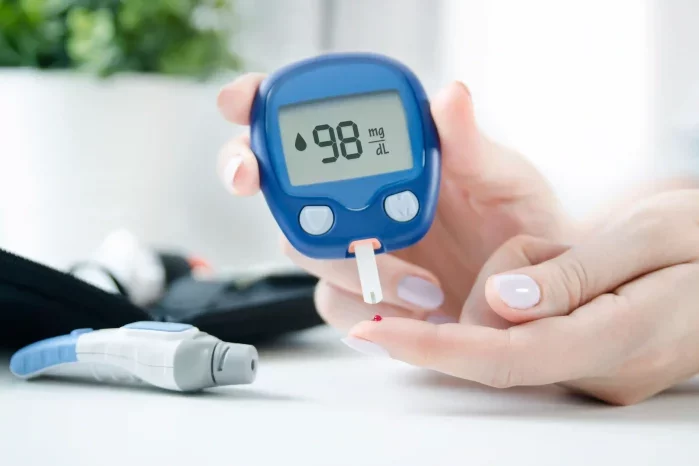Insulin resistance and diabetes are closely related metabolic disorders that affect how the body processes glucose, but they are not the same. Insulin resistance is a condition in which the body’s cells become less responsive to the hormone insulin, which is crucial for regulating blood sugar levels. Diabetes, particularly type 2 diabetes, often develops from insulin resistance but represents a more advanced stage of metabolic dysfunction. To fully understand the relationship between these two conditions, it’s essential to delve into their definitions, mechanisms, risk factors, and management strategies.
What is Insulin Resistance?
Insulin resistance occurs when the cells of the body—primarily in muscles, fat, and the liver—do not respond effectively to insulin. Insulin is a hormone produced by the pancreas that facilitates the uptake of glucose (sugar) from the bloodstream into cells, where it is used for energy or stored for future use. When cells become resistant to insulin, the pancreas compensates by producing more insulin. This leads to higher levels of insulin in the blood, a condition known as hyperinsulinemia.
Mechanisms of Insulin Resistance
The exact mechanisms behind insulin resistance are complex and involve multiple factors, including genetic predisposition, obesity, inflammation, and lifestyle factors such as diet and physical activity. Some key mechanisms include:
- Genetic Factors: Certain genes can predispose individuals to insulin resistance by affecting insulin signaling pathways and glucose metabolism.
- Obesity: Excess body fat, particularly visceral fat around the abdomen, is strongly linked to insulin resistance. Adipose tissue releases free fatty acids and inflammatory cytokines that interfere with insulin signaling.
- Inflammation: Chronic low-grade inflammation is a hallmark of insulin resistance. Inflammatory cytokines can impair insulin signaling and disrupt the normal function of insulin receptors on cells.
- Lifestyle Factors: Poor diet, characterized by high intake of refined carbohydrates and unhealthy fats, along with physical inactivity, contribute significantly to the development of insulin resistance.
Symptoms and Diagnosis of Insulin Resistance
Insulin resistance itself often does not produce noticeable symptoms in its early stages. However, it can lead to a cluster of conditions known as metabolic syndrome, which includes:
- Abdominal Obesity: Increased waist circumference.
- Hypertension: High blood pressure.
- Dyslipidemia: Abnormal levels of cholesterol and triglycerides.
- Hyperglycemia: Elevated blood glucose levels.
Diagnosis of insulin resistance typically involves a combination of blood tests and clinical assessments. Common tests include:
- Fasting Insulin Levels: Elevated levels may indicate insulin resistance.
- Glucose Tolerance Test (GTT): Measures the body’s response to glucose over time.
- HOMA-IR (Homeostatic Model Assessment of Insulin Resistance): A calculation based on fasting insulin and glucose levels.
What is Diabetes?
Diabetes mellitus is a chronic condition characterized by high levels of glucose in the blood. There are several types of diabetes, but the two most common are type 1 diabetes and type 2 diabetes.
Type 1 Diabetes
Type 1 diabetes is an autoimmune disease where the body’s immune system attacks and destroys the insulin-producing beta cells in the pancreas. As a result, individuals with type 1 diabetes produce little to no insulin and require lifelong insulin therapy. This form of diabetes usually manifests in childhood or adolescence, but it can also occur in adults.
Type 2 Diabetes
Type 2 diabetes is the most common form of diabetes and is strongly associated with insulin resistance. It typically develops in adults over the age of 45, but it is increasingly being diagnosed in younger populations, including children and adolescents. In type 2 diabetes, the body initially produces insulin, but the cells are resistant to its effects. Over time, the pancreas cannot keep up with the increased demand for insulin, leading to elevated blood glucose levels.
Symptoms and Diagnosis of Diabetes
The symptoms of diabetes, particularly type 2 diabetes, can be subtle and develop gradually. Common symptoms include:
- Frequent Urination: Excess glucose in the blood is excreted in urine, drawing water with it and causing increased urination.
- Excessive Thirst: The loss of water through frequent urination leads to dehydration and increased thirst.
- Unexplained Weight Loss: Despite normal or increased food intake, the body cannot effectively use glucose for energy, leading to weight loss.
- Fatigue: Lack of usable glucose results in low energy levels.
- Blurred Vision: High blood glucose levels can cause swelling in the lens of the eye, leading to blurred vision.
Diagnosis of diabetes involves several blood tests, including:
- Fasting Blood Glucose Test: Measures blood glucose levels after an overnight fast. A level of 126 mg/dL or higher on two separate tests indicates diabetes.
- A1C Test: Measures average blood glucose levels over the past 2-3 months. An A1C level of 6.5% or higher indicates diabetes.
- Oral Glucose Tolerance Test (OGTT): Measures blood glucose levels before and after consuming a glucose-rich drink. A level of 200 mg/dL or higher after 2 hours indicates diabetes.
The Connection Between Insulin Resistance and Type 2 Diabetes
Insulin resistance is a significant risk factor for the development of type 2 diabetes. The progression from insulin resistance to type 2 diabetes typically follows these stages:
- Compensated Insulin Resistance: The pancreas produces more insulin to overcome the resistance, maintaining normal blood glucose levels.
- Prediabetes: As insulin resistance worsens, the pancreas cannot produce enough insulin to maintain normal blood glucose levels, leading to elevated glucose levels that are not yet high enough to be classified as diabetes. Prediabetes is often diagnosed when fasting blood glucose levels are between 100-125 mg/dL or when A1C levels are between 5.7%-6.4%.
- Type 2 Diabetes: Persistent insulin resistance and beta-cell dysfunction result in chronic hyperglycemia, leading to the diagnosis of type 2 diabetes.
Risk Factors for Progression
Several factors increase the risk of progressing from insulin resistance to type 2 diabetes, including:
- Obesity: Particularly central obesity, which is a strong predictor of insulin resistance and diabetes.
- Sedentary Lifestyle: Lack of physical activity exacerbates insulin resistance.
- Unhealthy Diet: Diets high in refined carbohydrates, sugars, and unhealthy fats contribute to insulin resistance.
- Genetics: Family history of type 2 diabetes increases the risk.
- Age: The risk of type 2 diabetes increases with age.
- Ethnicity: Certain ethnic groups, including African Americans, Hispanics, Native Americans, and Asian Americans, are at higher risk.
Management and Prevention Strategies
Managing Insulin Resistance
The primary goal in managing insulin resistance is to improve the body’s sensitivity to insulin. This can be achieved through lifestyle modifications and, in some cases, medication. Key strategies include:
Dietary Changes:
- Balanced Diet: Emphasize whole grains, lean proteins, healthy fats, fruits, and vegetables.
- Low Glycemic Index Foods: Choose foods that have a lower impact on blood glucose levels.
- Portion Control: Maintain appropriate portion sizes to avoid overeating.
Physical Activity:
- Regular Exercise: Aim for at least 150 minutes of moderate-intensity aerobic exercise per week, combined with resistance training.
- Weight Loss: Even a modest weight loss of 5-10% can significantly improve insulin sensitivity.
Medications:
- Metformin: Commonly prescribed to improve insulin sensitivity and lower blood glucose levels.
- Thiazolidinediones: Another class of drugs that enhance insulin sensitivity.
Managing Type 2 Diabetes
Management of type 2 diabetes involves a multifaceted approach to control blood glucose levels and prevent complications. Strategies include:
Lifestyle Modifications:
- Healthy Diet: Similar to the recommendations for insulin resistance, focusing on balanced, low glycemic index foods.
- Physical Activity: Regular exercise to improve insulin sensitivity and glucose control.
Medications:
- Oral Hypoglycemic Agents: Includes metformin, sulfonylureas, DPP-4 inhibitors, SGLT2 inhibitors, and others.
- Insulin Therapy: Required in cases where oral medications are insufficient to control blood glucose levels.
Monitoring:
- Blood Glucose Monitoring: Regular self-monitoring to track blood glucose levels and adjust treatment as needed.
- A1C Testing: Regular testing to assess long-term glucose control.
Education and Support:
- Diabetes Education Programs: Help patients understand their condition and how to manage it effectively.
- Support Groups: Provide emotional support and practical advice from others living with diabetes.
Prevention of Type 2 Diabetes
Preventing the progression from insulin resistance to type 2 diabetes involves addressing modifiable risk factors through lifestyle changes:
- Weight Management: Achieving and maintaining a healthy weight through a balanced diet and regular physical activity.
- Healthy Eating: Focusing on nutrient-dense foods, reducing intake of refined carbohydrates and unhealthy fats.
- Regular Physical Activity: Engaging in both aerobic and resistance exercises to improve insulin sensitivity.
- Regular Monitoring: For those at high risk, regular monitoring of blood glucose levels and early intervention can prevent or delay the onset of diabetes.
See also: How To Reverse Insulin Resistance
Conclusion
While insulin resistance and diabetes are interconnected, they are distinct conditions. Insulin resistance is a precursor to type 2 diabetes, marked by the body’s decreased ability to respond to insulin. Diabetes, particularly type 2, represents a more advanced stage where insulin production is insufficient to overcome resistance, leading to chronic hyperglycemia. Understanding the relationship between these conditions is crucial for effective prevention, management, and treatment strategies. By addressing risk factors and implementing lifestyle changes, individuals can improve insulin sensitivity and reduce the risk of progressing to type 2 diabetes.
Related topics:
What’s the Link Between Insulin Resistance and Hypertension
What’s the relationship of Insulin Resistance and Heart Disease

























